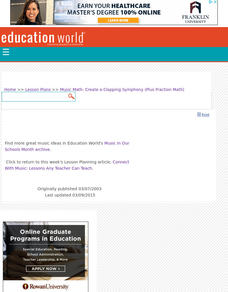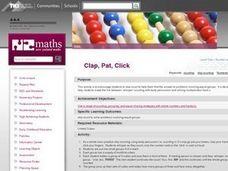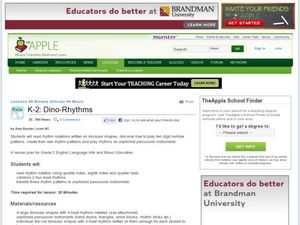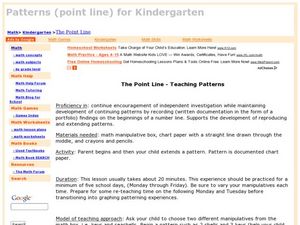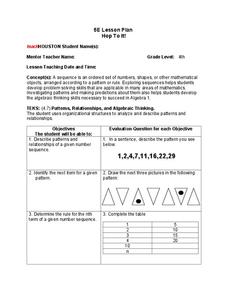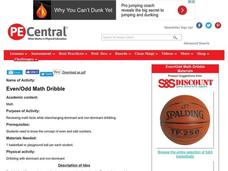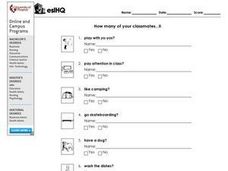Education Closet
Equal Rhythms
Engage young mathematicians in learning about fractions with this cross-curricular math and music lesson. After listening to and repeating different beat patterns, children realize that musical notes are just another way of representing...
Curated OER
Perspectives on Common Core: Student-Centered Math
Ditching paper and pencils can lead to great opportunities for collaborative learning and yes, even fun.
Illustrative Mathematics
Start/Stop Counting II
Take stroll around the classroom while teaching young mathematicians to count fluently with this whole-group math activity. The teacher starts things off by walking around the room while counting up from the number one and continues...
Curated OER
Rhythm and Counting
Students repeat patterns while listening to music. In this patterning lesson, students listen to a pattern on a tape of music and reproduce it by clapping or stamping their feet. They listen to stories about famous composers.
Curated OER
Music Math: Create a Clapping Symphony (Plus Fraction Math)
Students read simple music to create a symphony of clapping (all grades). Plus fraction math for grades 5-up. They explain how musical notes relate to fractions and identify a variety of musical notes for example, whole, half, and...
Curated OER
Clap, Pat, Click
First graders practice the art of skip counting to help them find the answer to problems involving equal groups. They are encouraged to make the link between "whisper" counting with body percussion and solving multiplication facts.
Curated OER
K-2: Dino-Rhythms
Second graders read rhythm notation and combine four-beat rhythms. In this rhythms lesson, 2nd graders read quarter notes, eighth notes, and quarter rests in rhythms that are written on dinosaur shapes. They clap, snap, or stamp out the...
Curated OER
Measuring to the Nearest Foot
Second graders measure and record the length of five different objects around the room. They watch as the teacher measures items using a ruler. A ruler is a foot long. Everyone listens and watches as the teacher continues to teach that a...
Curated OER
The Point Line - Teaching Patterns
Students practice extending patterns. In this patterns lesson plan, students demonstrate extending patterns by performing a rhythmic patter.
Curated OER
Manu's Song
Fourth graders observed the following pattern: snap, clap, snap, clap....Join my pattern when you know how it goes. After the all the students can follow the pattern ask them if they can use counters (2 colors) to show the pattern.
Ask...
Curated OER
Math: Musical Patterns
Students employ their five senses to interpret and duplicate instrumental patterns. Following the teacher's patterns, students clap their hands and later use instruments such as bells, triangles, or cymbals to create their own "songs."
Curated OER
Hop To It!
Students determine patterns. In this mathematics lesson, students act out a skit, play a sequence game, and complete patterns. Students use problems solving skills.
Hawaiʻi State Department of Education
Rhythm Patterns
Fractions can be tricky. Why not have kids think of fractions like they think of eighth, quarter, and half notes? In teams, the class creates four-measure patterns with their percussion instruments. They need to explain their rhythm...
Curated OER
Number and Shape Patterns
Review what constitutes a pattern, and have the kids create number and shape patterns of their own. An activity page requires them to name and identify simple numerical patterns.
Curated OER
Patterns
Explore early algebra by participating in a pattern identification activity using a random assortment of different household materials. The class creates, completes, and analyzes different patterns with the help of leggos, buttons,...
Curated OER
First Rhythmic Composition
Students apply fractions to counting rhythm in music. In this algebra lesson, students interrelate the concept of math into music as they fill out a chart identifying the names and symbols of music notes and their equivalent values in...
Curated OER
ESL: Classmates Survey
Get your beginning English Learners moving with this class survey. They ask each other the 8 questions provided to find out "How many of your classmates..." Good practice for asking questions that start with"Do you..." including "make...
Curated OER
Pattern Makers
Young scholars are introduced to the notion of a repeating pattern. This is done by a number of means including the use of everyday objects. They are encouraged to create, describe and continue patterns.
Curated OER
Even/Odd Math Dribble
Students review math facts while interchanging dominant and non-dominant dribbling.
Curated OER
Patterns in Dance
Third graders perform a line dance in the study of math as a pattern. They create and discuss movement solutions derived from movement exploration. They observe that patterns exist in the areas of music and dance and follow the...
Curated OER
What Time Is It?
For this telling time worksheet, students match seven clock faces with the sentence that states the time. On this page there are times shown to the nearest five minutes.
Curated OER
What Time Is It?
In this telling time in words learning exercise, students examine 4 clocks and match them to words that describe them best. The choices are: o'clock, half past, quarter past and "a clock." Note: The last choice is confusing; there should...
Curated OER
ESL- Taking a Classroom Survey
In this ESL classroom survey worksheet, students determine which of their classmates do things such as play with yo-yo's, pay attention in class, like camping or go skateboarding. They look at small clip art pictures of the activities to...
Curated OER
ESL How Many of Your Classmates... IV Survey
In this ESL classroom survey worksheet, students determine how many of their classmate like or do the listed things. They ask classmates 8 questions such as: do they like pizza, go to school by bus, or go in-line skating.






